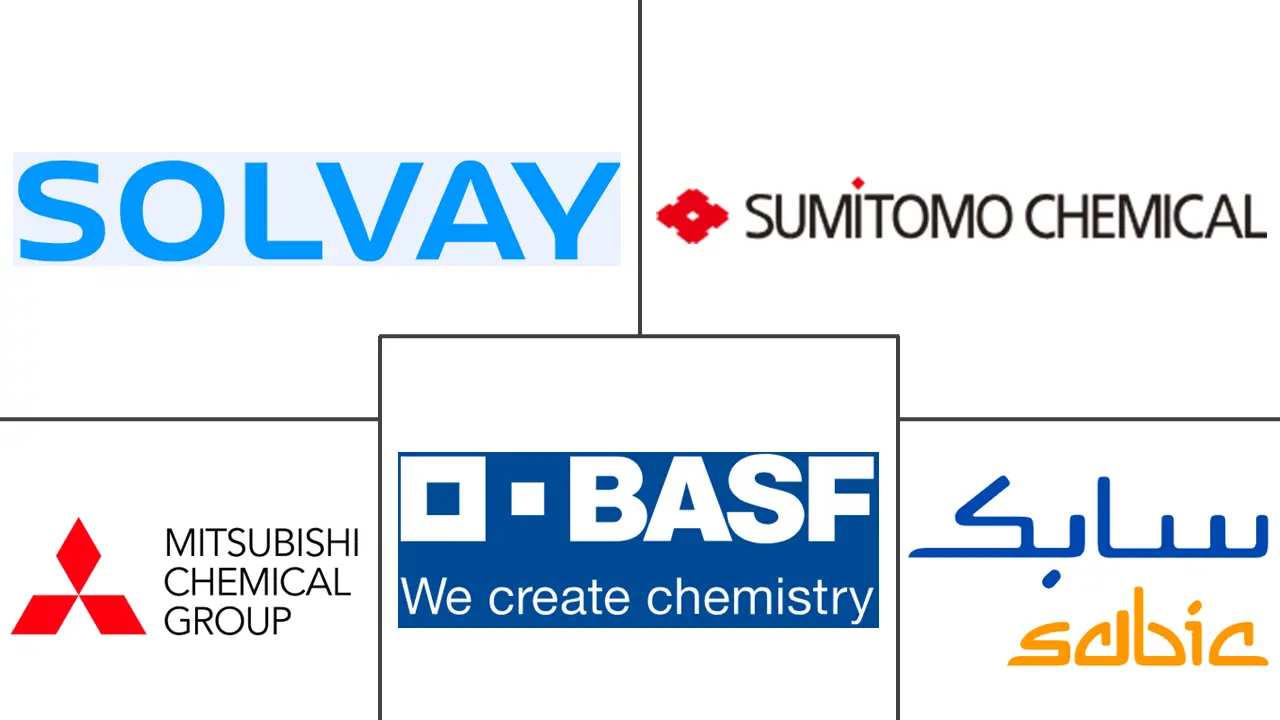Polyarylsulfone Market Size and Share

Polyarylsulfone Market Analysis by Mordor Intelligence
The Polyarylsulfone Market size is estimated at USD 1.73 billion in 2025, and is expected to reach USD 2.36 billion by 2030, at a CAGR of 6.45% during the forecast period (2025-2030). Demand growth mirrors the wider shift toward lightweight, high-temperature polymers that substitute metals without sacrificing mechanical strength. Medical device makers are scaling adoption because the FDA’s 21 CFR 177.1560 regulation authorizes polyarylsulfone resins for food contact at normal baking temperatures, which validates their sterility and chemical inertness. In parallel, electric-vehicle suppliers favor the material’s dimensional stability for battery pack components, while semiconductor tool builders value its solvent resistance in plasma etching chambers. Leading producers leverage integrated petrochemical assets to offset bisphenol-A price swings, and most have announced ISCC Plus or mass-balance grades to satisfy sustainability audits. The polyarylsulfone market therefore occupies a strategic middle ground between commodity engineering polymers and ultra-exotic resins.
Key Report Takeaways
- By type, polysulfone led with 39.77% of the polyarylsulfone market share in 2024, whereas polyphenylsulfone is projected to expand at a 6.98% CAGR through 2030.
- By end-user industry, medical devices accounted for 42.55% of the polyarylsulfone market size in 2024, while electronics is poised to grow at a 6.78% CAGR to 2030.
- By geography, Asia Pacific captured 42.22% of global revenue in 2024; the region is expected to post the fastest 7.56% CAGR between 2025 and 2030.
Global Polyarylsulfone Market Trends and Insights
Drivers Impact Analysis
| Driver | (~) % Impact on CAGR Forecast | Geographic Relevance | Impact Timeline |
|---|---|---|---|
| Rapid lightweight-ing push in EV & e-mobility platforms | +1.80% | Global, with early gains in China, Europe, North America | Medium term (2-4 years) |
| Medical OEM pivot toward reusable, steam-sterilizable components | +1.50% | Global, concentrated in North America & Europe | Short term (≤ 2 years) |
| Membrane retrofits in industrial & municipal water treatment | +1.20% | APAC core, spill-over to MEA | Long term (≥ 4 years) |
| Mainstream shift from metals to high-performance polymers in aerospace interiors | +0.90% | North America & EU | Medium term (2-4 years) |
| Rising demand for solvent-resistant housings in next-gen semiconductor tools | +0.80% | APAC core, with expansion to North America | Short term (≤ 2 years) |
| Source: Mordor Intelligence | |||
Rapid Lightweighting Push in EV & E-mobility Platforms
Electric-vehicle producers are using polyarylsulfone in battery enclosures that demonstrate 20% weight reduction versus conventional aluminum housings, a milestone shown in SABIC’s multi-material pack program[1]SABIC, “Advanced Battery Pack Enclosures,” sabic.com . The polymer’s heat-deflection temperature allows thin-wall structures that survive thermal runaway events, while intrinsic chemical resistance shields components from electrolyte spills. Tier-1 suppliers highlight tooling productivity gains because complex geometries can be injection-molded in one shot, lowering assembly cost. Automakers also exploit the resin’s dielectric strength to design integrated cooling plates that double as electrical insulators. As pack energy density rises, these combined advantages translate into longer driving range, reinforcing adoption momentum.
Medical OEM Pivot Toward Reusable, Steam-Sterilizable Components
Hospitals are shifting from single-use to reusable surgical sets to reduce per-procedure expenditure by up to 60%, and polyarylsulfone meets repeated autoclave cycles without loss of clarity or toughness. ISO 10993-1 biocompatibility clearance for Udel PSU and Radel PPSU simplifies device registration in the United States and European Union. Instrument suppliers now specify transparent grades so clinicians can visually inspect internal channels, cutting downtime linked to hidden contamination. Pigmented variants for color-coded trays streamline workflow and lower identification errors in the operating room. With health systems pursuing both cost containment and sustainability, demand from surgical tools, sterilization cases, and dental equipment remains robust.
Membrane Retrofits in Industrial & Municipal Water Treatment
Ageing ultrafiltration lines are being upgraded with polyarylsulfone-based hollow fibers that hit 99% removal rates for selected PFAS contaminants. The material tolerates sodium hypochlorite and caustic cleans without cracking, stretching replacement intervals to five years in municipal service. Researchers have boosted flux by grafting hydrophilic nanomaterials onto the polymer backbone, generating composite membranes that water utilities can slot into legacy housings with minimal retrofit expense[2]Royal Society of Chemistry, “Nanocomposite Sulfone Membranes,” rsc.org . These performance gains arrive as APAC governments tighten discharge norms, unlocking a long-duration growth runway.
Mainstream Shift from Metals to High-Performance Polymers in Aerospace Interiors
Thermoplastic fuselage demonstrators under CleanSky 2 achieved 20–30% CO₂ reductions relative to today’s structures by substituting polyarylsulfone composites for aluminum frames. Airlines value cabin parts that satisfy FAR 25.853 fire-smoke-tox requirements while trimming weight and easing MRO inspections. The polymer’s fracture toughness resists fatigue over thousands of pressurization cycles, cutting life-cycle costs. Emerging conductive grades also provide electromagnetic interference shielding without metallic inserts, helping airframers meet next-generation avionics compatibility targets. These attributes align with aerospace electrification trends, placing the polymer on qualified material lists for interior monuments and cable conduits.
Restraints Impact Analysis
| Restraint | (~) % Impact on CAGR Forecast | Geographic Relevance | Impact Timeline |
|---|---|---|---|
| Volatile bisphenol-A & diphenylsulfone prices | -1.20% | Global, with acute impact in APAC | Short term (≤ 2 years) |
| Delayed regulatory approvals for food-contact grades | -0.80% | North America & EU | Medium term (2-4 years) |
| Recycling infrastructure gap for high-temperature thermoplastics | -0.60% | Global, most pronounced in emerging markets | Long term (≥ 4 years) |
| Source: Mordor Intelligence | |||
Volatile Bisphenol-A & Diphenylsulfone Prices
Feedstock volatility narrows producer margins because bisphenol-A spot prices swing with benzene and phenol supply cycles. California’s listing of bisphenol S as a reproductive toxicant adds uncertainty, prompting formulators to resource-shift or requalify grades at extra cost. Contract hedging only partially offsets price spikes, so processors push surcharges downstream, raising finished good pricing and dampening substitution in cost-sensitive sectors. Vertical integration helps majors absorb shocks; however, independent compounders face inventory-finance strain during up-cycles.
Delayed Regulatory Approvals for Food-Contact Grades
Although 21 CFR 177.1560 covers baseline resins, any colorant or recycled-content variant triggers fresh extractables testing that can extend to 24 months[3]U.S. Food & Drug Administration, “Food-Contact Notification Program,” fda.gov . Smaller suppliers lacking in-house toxicology teams must outsource dossiers, inflating development budgets. Multinational brand owners avoid unapproved materials to protect supply-chain continuity, so commercial roll-out lags technical readiness. This bottleneck especially restricts adoption in baby-care articles and industrial bakeware, where compliance evidence remains paramount.
Segment Analysis
By Type: Performance Differentiation Guides Purchasing Decisions
Polysulfone segment captured 39.77% of the global market share in 2024, emphasizing its significant contribution to overall revenue. Medical, filtration, and aerospace programs lean on PSU’s well-documented datasheets, which limit qualification time. Producers emphasize melt-flow consistency that supports multi-cavity tooling, and this reliability keeps cost-of-quality low for high-volume disposables. Meanwhile, supply-chain alliances between resin makers and compounders bring pre-colored PSU pellets directly to device molders, eliminating masterbatch steps.
Polyphenylsulfone commands premium pricing yet is on track to outpace every other grade at a 6.98% CAGR by 2030. PPSU’s impact strength allows thinner battery module frames than PEI or PEEK can deliver at comparable cost. Syensqo cites a 207 °C heat-deflection rating that safeguards under-hood brackets near turbochargers while absorbing vibration without micro-cracks. Polyethersulfone, in contrast, targets membrane casting and transparent lab ware, offering a cost-performance midpoint that appeals to price-sensitive Asian OEMs. Collectively, these differentiated value propositions lock in long-term offtake agreements and deter commoditization.
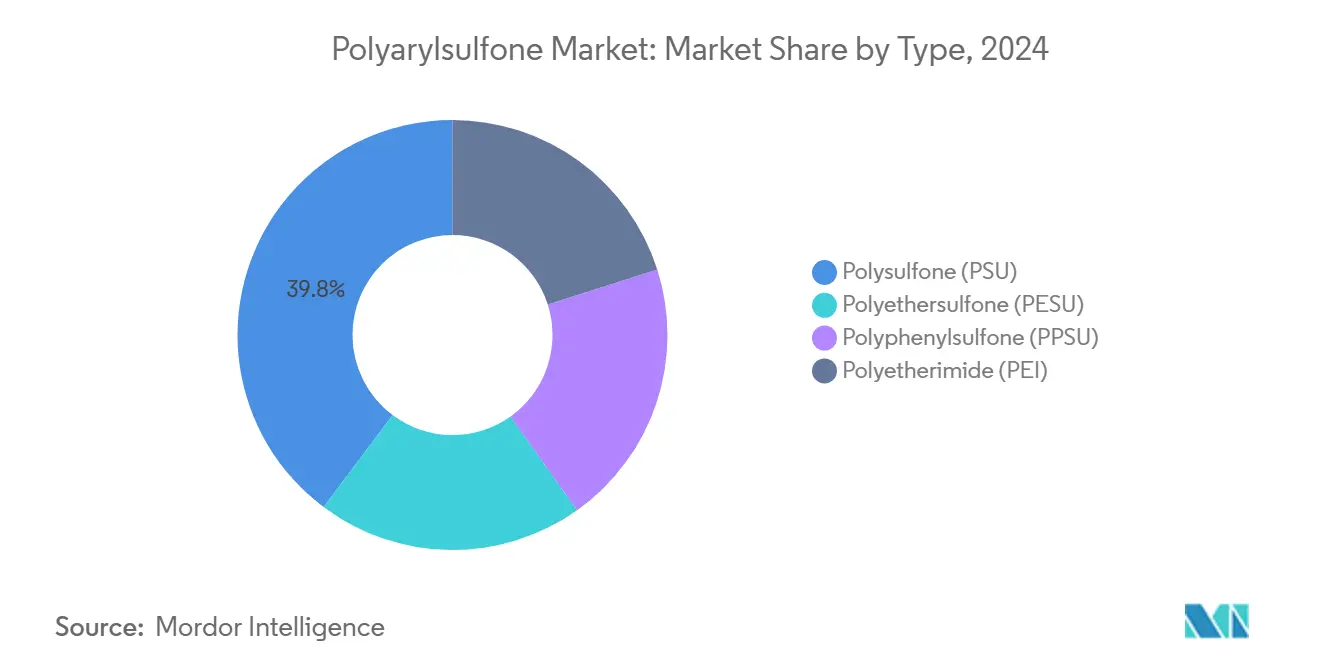
Note: Segment shares of all individual segments available upon report purchase
By End-User Industry: Healthcare Provides Scale; Electronics Delivers Momentum
Medical accounted for 42.55% of the polyarylsulfone market in 2024. Autoclave compatibility enables forceps, sterilization trays, and hemodialysis components that survive 1,000 steam cycles, giving hospitals confidence to amortize capital goods across multiple fiscal years. Transparency supports visual inspection and fosters photonic biosensors integrated into lab-on-chip devices, expanding addressable use cases. In orthopedics, radiolucent trial implants simplify intraoperative imaging, lowering radiation exposure for staff and patients alike.
Electronics are projected to achieve the highest growth, registering a notable 6.78% CAGR by 2030. Semiconductor OEMs specify PPSU and PESU housings for dry-etch chambers because the resins endure fluorine plasmas that etch metals within minutes. BASF’s new high-flow Ultrason D 1010 G6 U40 ensures consistent fiber-glass wet-out, allowing tight-tolerance flanges that seal against vacuum leaks. Consumer devices also embed polyarylsulfone into USB-C power adapters where thin walls must pass glow-wire tests at 850 °C. As IoT demand rises, enclosure suppliers appreciate the polymer’s inherent flame retardancy, eliminating halogenated additives and simplifying end-of-life recycling.
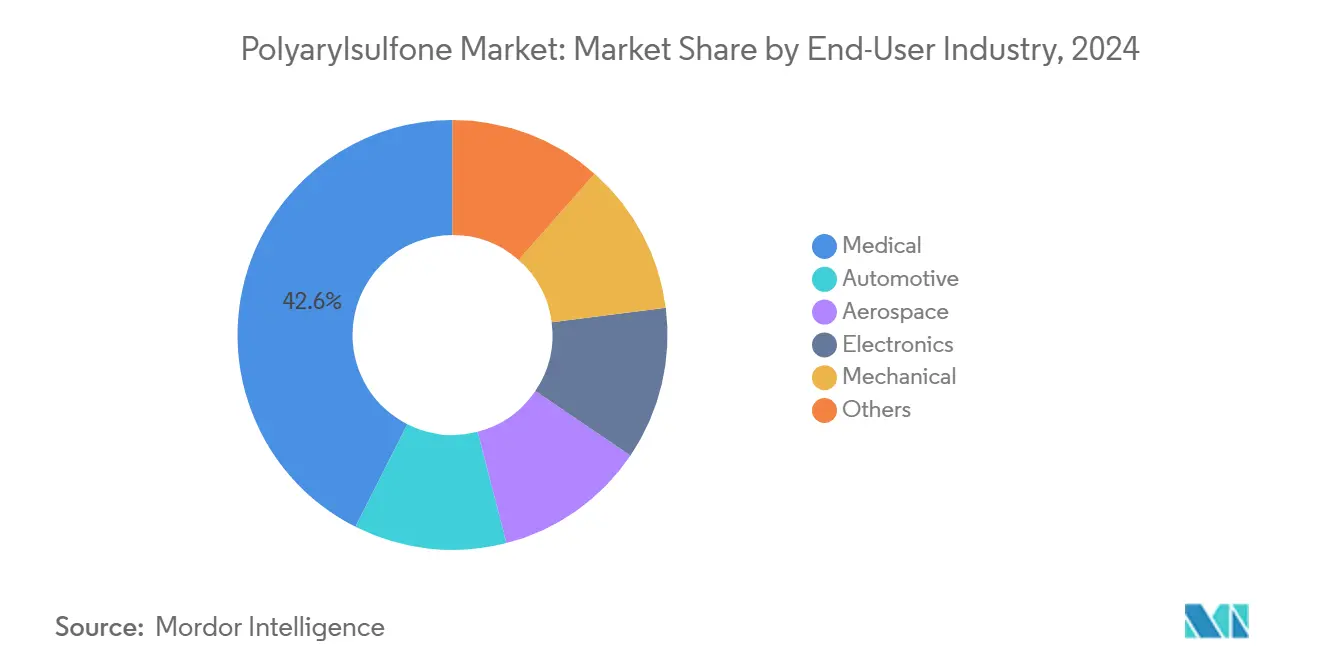
Note: Segment shares of all individual segments available upon report purchase
Geography Analysis
Asia Pacific held 42.22% of the polyarylsulfone market share in 2024, supported by China’s 5.48 million t/y bisphenol-A capacity and regional government incentives for high-tech plastics. Local converters integrate vertically from BPA to sulfone monomers, compressing conversion costs and shortening lead times to electronics and EV clusters. Japanese producers refine ultra-high-purity grades for surgical lighting lenses and semiconductor quartz replacements, reinforcing the region’s advanced-manufacturing pedigree. Supply-chain concentration, however, exposes Western OEMs to geopolitical risk, prompting dual-sourcing strategies with Korean and Indian suppliers.
North America remains a value-added hub focused on FDA-cleared medical disposables and FAA-certified aerospace interiors. Resin producers invest in compounding plants near major med-tech corridors in Minnesota and Massachusetts, cutting transit carbon. OEM preference for recycled content pushes suppliers to pilot solvent-based depolymerization that reclaims monomers at 95% yield. Federal procurement policies tied to Buy American clauses may accelerate localized capacity, cushioning the market from Asian supply disruptions.
Europe’s policy mix balances REACH chemical scrutiny with circular-economy targets. German automakers embed polyarylsulfone in thermal-management manifolds for battery electric vehicles, aiming to halve component weight versus aluminum. Continental water utilities retrofit hollow-fiber membranes to comply with the Drinking Water Directive’s stricter PFAS limits, and EU recovery funds earmarked for green infrastructure underpin volume growth. Eastern Europe offers cost-competitive molding, drawing inward investment from Western compounders seeking tariff-free access to the single market.
South America and the Middle East & Africa trail in volume but show double-digit demand in water treatment and oil-gas applications. Governments favor durable membranes to offset capital constraints, and climate-driven droughts make desalination capacity urgent. Gulf-region petrochemical majors evaluate backward-integration into sulfones, leveraging existing phenol production, which could shift global trade flows post-2027 if projects proceed.
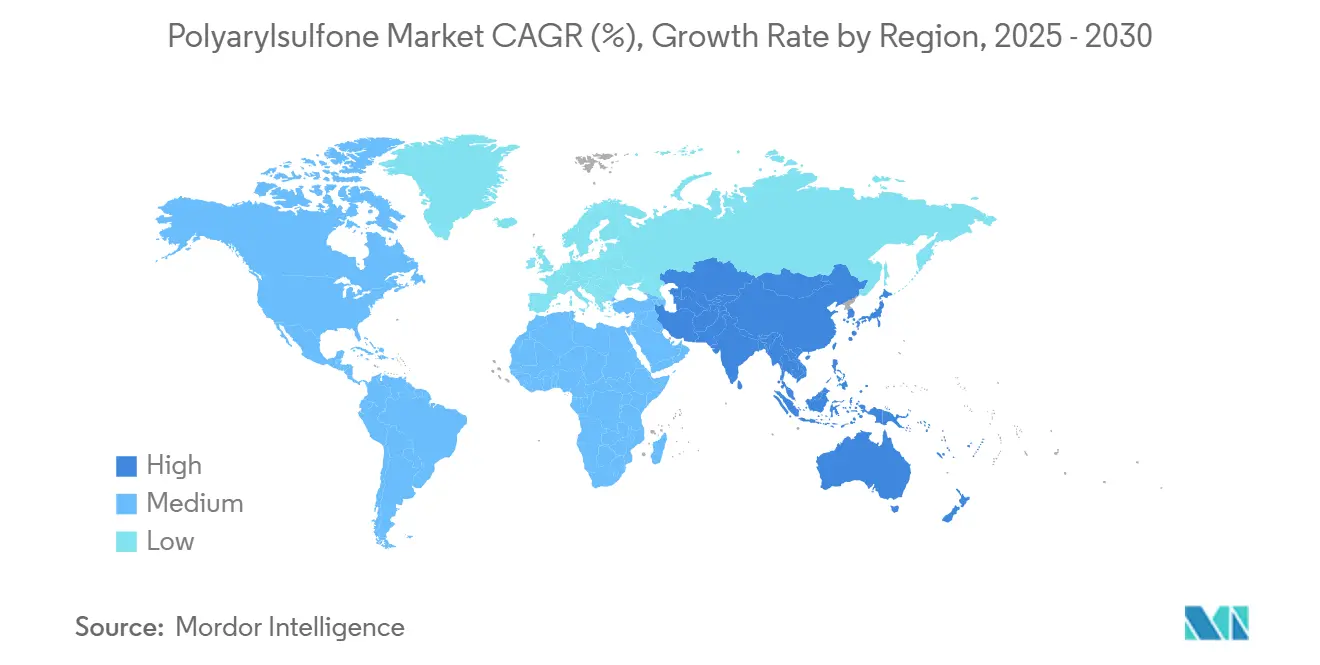
Competitive Landscape
Industry structure skews toward moderately consolidated concentration. Solvay, BASF, and SABIC account for almost half of the installed capacity, benefiting from captive phenol, acetone, and sulfur trioxide streams. Their integrated models yield cost baselines 8–10% below independent compounders, permitting sustained R&D outlays in specialty grades. Solvay’s Fulcrum recycling pilot in Belgium converts post-industrial PSU waste into high-purity monomer, aligning with OEM decarbonization metrics. BASF partners with Encina Development Group to secure chemically recycled benzene, bolstering its circular feedstock pipeline.
Mid-tier players build regional presence through price leadership but face qualification gaps in medical and aerospace markets where documentation depth trumps cost. Custom compounders like RTP Company capture niches via rapid color matching and flame-retardant packages.
Innovation fronts center on fiber-reinforced pellets for structural auto parts, transparent grades with UV-blocking nanofillers for laboratory optics, and sulfone-carbon-nanotube blends that dissipate static in semiconductor fabs. Patent landscapes reveal a surge in surface-grafting techniques that improve hydrophilicity of filtration membranes without compromising chlorine resilience. Companies that commercialize these enhancements earliest will differentiate on lifecycle cost and ESG credentials.
Polyarylsulfone Industry Leaders
-
Solvay
-
BASF SE
-
SABIC
-
Sumitomo Chemical Co., Ltd.
-
Mitsubishi Chemical Corporation
- *Disclaimer: Major Players sorted in no particular order
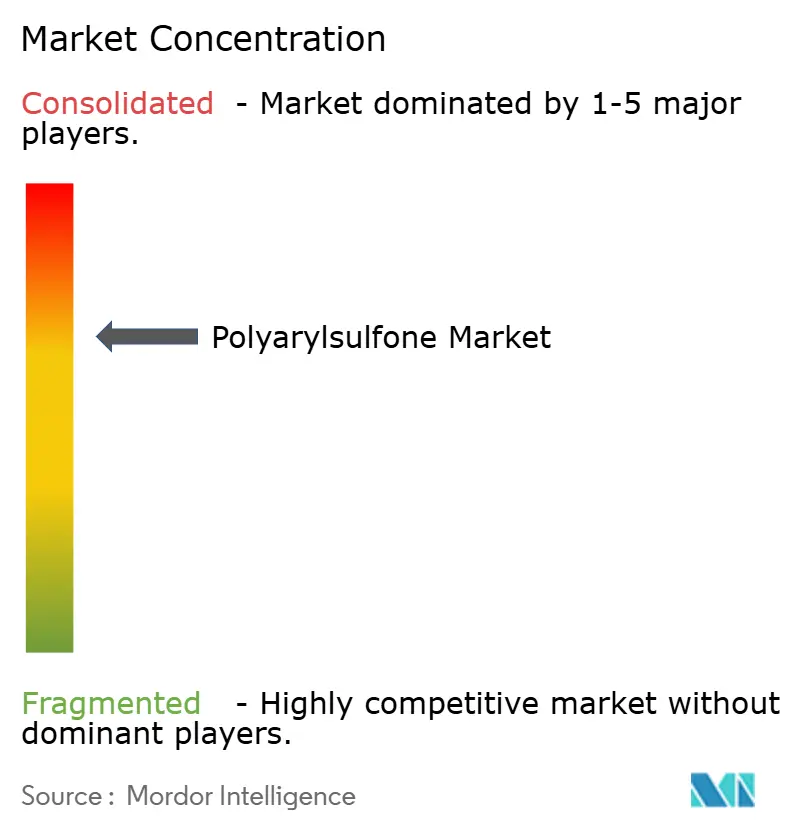


Recent Industry Developments
- March 2025: BASF has introduced the high-flow Ultrason D 1010 G6 U40, specifically designed for challenging E&E components. This polyethersulfone (PESU)-based blend is engineered to facilitate efficient injection molding, addressing the energy-efficient requirements of data and energy transmission, smart electronics, and e-mobility.
- September 2024: Syensqo introduced its innovative material solutions at Fakuma 2024, including ISCC Plus mass balance-certified polysulfone resins designed to support customers in meeting their sustainability objectives.
Global Polyarylsulfone Market Report Scope
Polyarylsulfones are a family of high-performance thermoplastics which contain an aryl-SO2-aryl subunit and are known for their toughness and stability at high temperatures. The amorphous high-temperature polymers of the polyarylsulfone family are characterized by extraordinary, inherent flame retardancy and high transparency. The polyarylsulfone market is segmented by type, end-user industry, and geography. The market is segmented by type into polysulfone, polyethersulfone, polyphenylsulfone, and polyethyleneimine. The end-user industry segments the market into automotive, aerospace, electronics, medical, mechanical, and other industries. The report also covers the market size and forecasts for polyarylsulfone in 17 countries across major regions. Each segment's market sizing and forecasts are based on revenue (USD million).
| Polysulfone (PSU) |
| Polyethersulfone (PESU) |
| Polyphenylsulfone (PPSU) |
| Polyetherimide (PEI) |
| Automotive |
| Aerospace |
| Electronics |
| Medical |
| Mechanical |
| Others |
| Asia-Pacific | China |
| India | |
| Japan | |
| South Korea | |
| Rest of Asia-Pacific | |
| North America | United States |
| Canada | |
| Mexico | |
| Europe | Germany |
| United Kingdom | |
| France | |
| Italy | |
| Rest of Europe | |
| South America | Brazil |
| Argentina | |
| Rest of South America | |
| Middle East and Africa | Saudi Arabia |
| South Africa | |
| Rest of Middle East and Africa |
| By Type | Polysulfone (PSU) | |
| Polyethersulfone (PESU) | ||
| Polyphenylsulfone (PPSU) | ||
| Polyetherimide (PEI) | ||
| By End-User Industry | Automotive | |
| Aerospace | ||
| Electronics | ||
| Medical | ||
| Mechanical | ||
| Others | ||
| By Geography | Asia-Pacific | China |
| India | ||
| Japan | ||
| South Korea | ||
| Rest of Asia-Pacific | ||
| North America | United States | |
| Canada | ||
| Mexico | ||
| Europe | Germany | |
| United Kingdom | ||
| France | ||
| Italy | ||
| Rest of Europe | ||
| South America | Brazil | |
| Argentina | ||
| Rest of South America | ||
| Middle East and Africa | Saudi Arabia | |
| South Africa | ||
| Rest of Middle East and Africa | ||


Key Questions Answered in the Report
What is the current size of the polyarylsulfone market?
The market stands at USD 1.73 billion in 2025 and is projected to reach USD 2.36 billion by 2030.
Which end-use sector holds the largest share?
Medical devices lead with 42.55% of revenue because polyarylsulfone withstands repeated steam sterilization.
Why is Asia Pacific so dominant in the polyarylsulfone market?
The region integrates raw materials through to compounding, and its electronics and EV supply chains drive demand growth at a 7.56% CAGR.
What makes polyphenylsulfone the fastest-growing grade?
PPSU offers superior impact strength and chemical resistance, enabling new applications such as EV battery housings that justify its premium price.
How are suppliers addressing sustainability concerns?
Major producers have introduced ISCC Plus-certified and chemically recycled grades, and some are piloting depolymerization to reclaim sulfone monomers for reuse.
Page last updated on:
